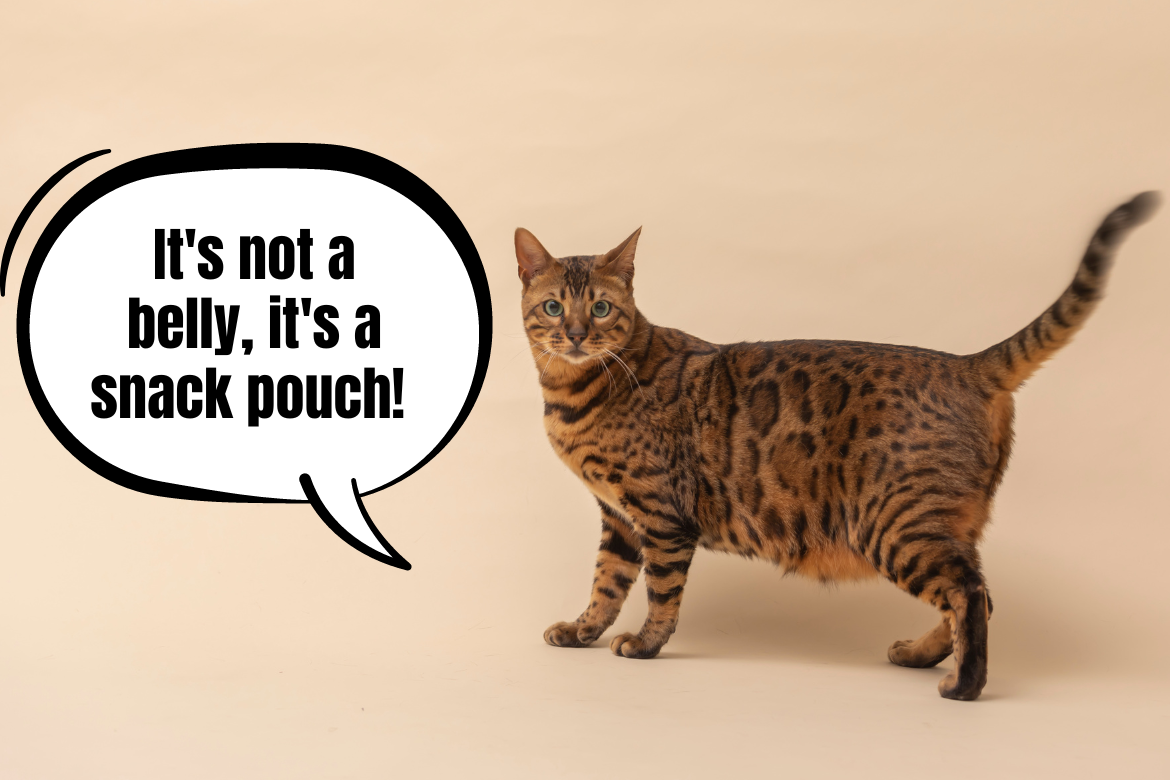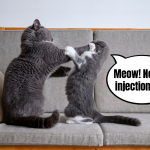Is the floppy belly of a cat a reason to be worried? Not necessarily! Although cats, just like hoomans, can suffer from obesity, a droopy belly is not always a sign of the cat not being fit or that it’s time to jump onto the scratcher gym. The soft, saggy flap of skin under a cat’s belly is called a primordial pouch, also known as a snack pouch or a kitty apron. What purpose does it have, and why is it visible in some cats more than others? Let’s find out!

Primordial pouch – get to know the secret part of a cat’s body
The primordial pouch, a loose flap of skin under the cat’s belly, is one of the best examples of how many similarities there are between domestic cats and their wild ancestors and how little, despite the time passed, the cat’s body has changed over the years. The existence of the “kitty apron” is all thanks to evolution – the extra space around the belly area lets cats be more flexible and agile, protects the sensitive belly and, in times of food shortages, it can become an extra fat storage that will provide extra energy necessary to survive.
The main functions of the “kitty apron” are:
- The extra flap of skin on the cat’s belly lets the cat be more stretchy in the lower area of their body during runs and long jumps, whether the cat is chasing their prey, a laser pointer, or if they’re running away to hide from the vet.
- Primordial pouch “increases” the volume of the cat’s stomach – cats are used to eating small meals a few times a day but if they know they won’t have such luxury, the extra flap of skin lets them eat more until they’re full and store the extra fat “for later”, in case of an unexpected hunger with no food around.
- The pouch under the cat’s belly protects the most vulnerable parts of the cat’s body. The extra layer of skin and fat shields the organs from damage, e.g. during fights with other cats (nobody wants to get bunny-kicked right in the belly).
The functions of the primordial pouch are useful for both big, wild cats like lions and tigers, and for smaller domestic cats who, despite having no need to store extra food supplies, still appreciate the flexibility of the body and an extra layer of fatty protection tha their pouch gives them.

Skin flaps on a cat’s belly – a medical condition or the cat’s charm?
Knowing that the presence of a flap of skin on a cat’s belly is completely normal, you might be wondering, fabCat: why does my friend’s cat not have the pouch while my kitty looks like they’re dragging their belly on the ground? The answer is simple: that’s just the cat’s charm. As it turns out, although the primordial pouch is something normal for all cats, for some breeds it’s more visible than for others. The presence of a more prominent primordial pouch might be due to age (older cats have less stretchy skin, so it’s more prone to sagging), breed, genetics, as well as physical activity, eating habits, and lifestyle. A low-hanging belly is not a reason to worry – it’s not a medical condition, just a simple (though cute) part of a cat’s body 🙂
So when should we consider our cat having too much fatty tissue? The moment the floppy belly stops being just their typical body part and becomes storage for extra fat and calories that come from a bad diet, lack of activity, and a static lifestyle. It’s difficult to find one “golden” weight for all cats but you can assess their body shape by looking at it from up top and the side and feeling for the ribs under the skin and fat. You can ask your vet or a cat dietitian to do a body assessment on your cat, trusting they understand the cat’s body much better and will be able to show you the differences between a skinny cat, a fit cat, and a fat cat. If you want to find examples on your own, simply google: cat body condition score”.

Does your cat have a big pouch?
Don’t worry! It’s not something that takes away your cat’s charm or puts you, their fabCat Carer, in a bad light. Despite some myths being spread around, a floppy belly is not a consequence of the cat being spayed (which is often pinned as the reason for a cat’s obesity) nor a sign that you give your cat too many snacks. As long as you’re watching your cat’s diet and know that their body is in the best shape possible, a floppy belly is just another part of the body that we, cat Carers, can swoon over 🙂 And which cats have the best chance for a visible primordial pouch? You can find it most often on Bengal cats, Egyptian Mau, hairless cats (just because their skin draws more attention), and often British shorthair cats.
What do your cats’ bellies look like, fabCats? Today we’re celebrating them all – the small ones, the big ones, the low-hanging ones, and the round bellies of well-fed kittens. Come over to our Facebook profile and show photos of your kitties with their fluffy aprons – we’re waiting for you at https://www.facebook.com/myKottypl.




